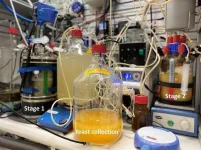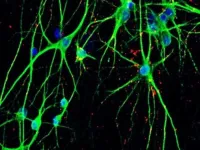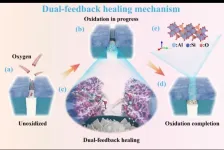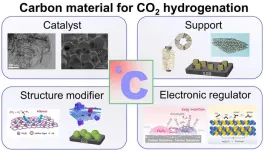(Press-News.org) Researchers in Germany can harvest protein and vitamin B9 from microbes by feeding them nothing much more than hydrogen, oxygen, and CO2. The technology, published September 12 in the Cell Press journal Trends in Biotechnology, runs on renewable energy to produce a sustainable, micronutrient-enriched protein alternative that may one day make it to our plates.
“This is a fermentation process similar to how you make beer, but instead of giving the microbes sugar, we gave them gas and acetate,” says corresponding author Largus Angenent of the University of Tübingen, Germany. “We knew that yeast could produce vitamin B9 on their own with sugar, however, we didn’t know if they could do the same with acetate.”
“We are approaching 10 billion people in the world, and with climate change and limited land resources, producing enough food will become harder and harder,” says Angenent. “One alternative is growing proteins in bioreactors through biotechnology rather than growing crops to feed animals. It makes agriculture much more efficient.”
The team designed a two-stage bioreactor system that produces yeast rich in protein and vitamin B9. This vitamin is also known as folate and is essential for bodily functions like cell growth and metabolism. In the first stage, the bacterium Thermoanaerobacter kivui converts hydrogen and CO2 into acetate, which is found in vinegar. In the second stage, Saccharomyces cerevisiae, more commonly known as baker’s yeast, feeds on acetate and oxygen to make protein and vitamin B9. The hydrogen and oxygen can be produced by zapping water with electricity produced by clean energy sources like windmills, for example.
It turns out acetate-fed yeast produces about the same amount of vitamin B9 as those that eat sugar. Just 6 grams, or 0.4 tablespoon, of the harvested dried yeast meets the daily vitamin B9 requirement. The vitamin levels were measured by a team led by co-author Michael Rychlik at the Technical University of Munich, Germany.
For protein, the researchers found that the levels in their yeast exceed those of beef, pork, fish, and lentils. Eighty-five grams, or 6 tablespoons, of yeast provides 61% of daily protein needs, while beef, pork, fish, and lentils meet 34%, 25%, 38%, and 38% of the need, respectively. However, the yeast should be treated to rid compounds that can increase the risk of gout if consumed excessively. Even so, treated yeast still meets 41% of the daily protein requirement, comparable to traditional protein sources.
This technology aims to address several global challenges: environmental conservation, food security, and public health. Running on clean energy and CO2, the system reduces carbon emissions in food production. It uncouples land use from farming, freeing up space for conservation. Angenent also stresses that it will not outcompete farmers. Instead, the technology will help concentrate farmers to produce vegetables and crops sustainably. The team’s yeast may also help developing nations overcome food scarcity and nutritional deficiencies by delivering protein and vitamin B9.
But before picking up the research team’s yeast at a grocery aisle as a protein alternative, Angenent says there’s much more to do. They plan to optimize and scale up production, investigate food safety, conduct technical and economic analyses, and gauge market interest.
“The fact that we can make vitamins and protein at the same time at a pretty high production rate without using any land is exciting,” says Angenent. “The end product is vegetarian/vegan, non-GMO, and sustainable, which could appeal to consumers.”
###
This work was supported by the Alexander von Humboldt Foundation, the Federal Ministry of Education and Research in Germany, the Novo Nordisk Foundation CO2 Research Center (CORC), SPRIND GmbH, and the Federal Ministry of Education and Research.
Trends in Biotechnology, Schmitz et al., “Power-to-Vitamins: producing folate (vitamin B9) from renewable electric power and CO2 with a microbial protein system” https://www.cell.com/trends/biotechnology/fulltext/S0167-7799(24)00177-X
Trends in Biotechnology (@TrendsinBiotech) is a multi-disciplinary Cell Press journal publishing original research and reviews on exciting developments in biotechnology, with the option to publish open access. This journal is a leading global platform for discussion of significant and transformative concepts across applied life sciences that examine bio-based solutions to real-world problems. Trends in Biotechnology provides cutting-edge research that breaks new ground and reviews that provide insights into the future direction of the field, giving the reader a novel point of view. Visit https://www.cell.com/trends/biotechnology. To receive Cell Press media alerts, contact press@cell.com.
END
Neurodevelopmental and psychiatric disorders (NPD) including schizophrenia, bipolar disorder, autism, and depression are detrimental to individuals, their families and society as a whole, and in many cases still lack effective treatments. It’s becoming more and more clear that genetic mutations in certain genes can increase the likelihood of developing NPD, and several hundreds of those “risk genes” have been identified to date, but their role related to NPD remains a mystery. “Very little is known about the basic function of most of these genes, and what we do know ...
About The Study: This case report describes a woman who presented with bilateral blurry vision a few days after dyeing her hair with hair dye containing aromatic amines.
Corresponding Author: To contact the corresponding author, Nicolas Chirpaz, MD, email nicolas.chirpaz@chu-lyon.fr.
To access the embargoed study: Visit our For The Media website at this link https://media.jamanetwork.com/
(doi:10.1001/jamaophthalmol.2024.3453)
Editor’s Note: Please see the article for additional information, including other authors, author contributions and affiliations, conflict of interest and financial ...
About The Study: This study found that certain social determinants of health affected monitoring for diabetic retinopathy similarly for Black and white patients with diabetes while others affected them differently. Patients living in rural communities, Black patients with preexisting diabetic retinopathy, and Hispanic white patients were not receiving eye care in accordance with clinical practice guidelines, which may contribute to worse outcomes.
Corresponding Author: To contact the corresponding author, Dustin D. French, PhD, email dustin.french@northwestern.edu.
To access the embargoed ...
About The Study: This single-center cohort study identified substantial overall survival disparity and differing frequencies of driver gene variations by race and ethnicity. Socioeconomic status had the largest contribution but accounted for less than one-third of the disparity, with substantial contribution from tumor molecular features. Further study of the associations of genetic ancestry and the molecular pathogenesis of colorectal cancer with chemotherapy response is needed.
Corresponding ...
City of Hope and Biopharmaceutical Research Company announce first patient has received BRC-001, a first-in-class cannabinoid therapeutic, in a clinical trial investigating supportive care in breast cancer
Researchers will evaluate whether the cannabinoid therapeutic candidate can address joint pain resulting from cancer treatment using aromatase inhibitors
This side effect has caused many breast cancer patients to discontinue treatment
LOS ANGELES and MONTEREY, Calif. — City of Hope®, one of the largest cancer research and treatment organizations in the United States, and Biopharmaceutical Research ...
Connecticut, U.S.A -- Some chemicals create environmental problems; others, fortunately, can help clean them up.
Chemists from Yale University and their colleagues have developed an electrochemical catalyst and membrane that offers an efficient and sustainable way to treat water contaminated with trichloroethylene (TCE), a common and persistent environmental pollutant. Their findings highlight the potential for advanced electrochemical treatments in environmental remediation and open the door for further innovations in the field.
Their results were published in Carbon Future ...
Fiber-reinforced ceramic matrix composites (CMCs) have been the primary choice for radome materials in hypersonic vehicles due to their high toughness, strength, and other advantageous properties. However, oxidation by oxygen in the atmospheric environment at elevated temperatures remains a significant obstacle to their further development. Thermal protection coatings offer a crucial avenue to mitigate this issue. Nonetheless, inherent material differences or fiber orientations within CMCs can lead to disparate thermal expansion rates between the matrix and fibers during temperature variations, inevitably ...
PLYMOUTH MEETING, PA [September 12, 2024] — The National Comprehensive Cancer Network® (NCCN®)—an alliance of leading cancer centers—and the NCCN Foundation® proudly announce plans to make every book in the library of NCCN Guidelines for Patients® available in Spanish; with select editions available in additional languages as well.
NCCN publishes the NCCN Guidelines for Patients library through funding from the NCCN Foundation. It now features more than 70 books with easy-to-understand information about prevention, ...
One of the primary drivers of climate change, CO2 emissions, have reached over 35 million tons worldwide. With global annual temperatures still rising, reducing CO2 emissions has become a necessity. To turn this necessity into an opportunity, researchers have been working to find ways to capture the CO2, thereby reducing emissions and then converting that CO2 into valuable chemicals and fuels.
One of the difficulties in working with CO2 is that it is very thermodynamically stable. To overcome this, additional ...
Gastric cancer remains a formidable adversary, ranking as the fifth most common cancer and the third-leading cause of cancer-related deaths worldwide, with over 1,000,000 new cases and close to 770,000 deaths each year. In Singapore, gastric cancer ranks among the top 10 causes of cancer-related deaths and claims about 300 lives each year.
The peritoneum, the lining of the abdominal cavity, is frequently involved in advanced-stage cancers, including gastric, colon, pancreatic, and ovarian cancers. For gastric cancer, the peritoneum ...






